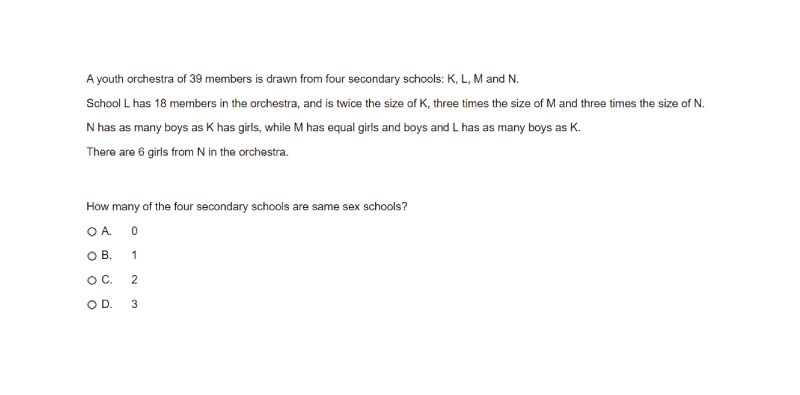Please be aware that the UCAT is undergoing major format changes in 2025. Primarily, the Abstract Reasoning Subtest will no longer be included in the exam. Please be aware of this when preparing for the UCAT and do not practice Abstract Reasoning questions as they are no longer relevant.
Welcome back to our blog on everything you need to know about the UCAT! This article is going to talk you through the Decision Making section of the test.
As we’ve done with the other sections, we’ve broken it down into small chunks so that you’re not overloaded with information. Hopefully by the time you finish reading this you feel ready to get started with some Decision Making practice questions!
Introduction to Decision Making
Decision Making is the second section of the UCAT.
It has only been part of the test since 2016, before which it was called ‘Decision Analysis’.
This section aims to assess your ability to apply logic to make decisions or reach a conclusion, analyse statistical data and evaluate arguments. It is the section of the test with the least amount of time pressure, so take advantage of this and use your time wisely!
Each question involves a passage of text or set of data, with questions that will present arguments to you. Your job in this section is to assess the information given and decide whether the statements given are valid and logical conclusions or not.

UCAT TUTORING BUNDLE
Get UCAT support from 6med to score highly and earn your offer.
Prepare yourself for the UCAT with one-to-one tuition from a UCAT expert, as well as comprehensive resources, an expert preparation course and full access to UCAT.Ninja, available as soon as you sign up.
UCAT.Ninja
UCAT.Ninja
We've got all the tips and tricks you need to score highly on the Decision Making Section.
Learn everything there is to know about the UCAT, with our UCAT Bundle and be guided by a tutor who scored in the top 10% – meaning you’re truly getting expert help.
Want to learn how to smash the UCAT, then this bundle is the one for you…


Why Is Decision Making included?
Decision Making is one of the most vital skills needed in the medical field.
One of the most important parts of your job as a doctor or dentist is to take information and make treatment decisions based on what is presented to you. In a clinical environment, this information will be given to you in the form of blood results, observations and clinical information you gather by speaking to your patients.
Often data can be conflicting and what the patient tells you may not match the clinical information you have at your disposal, so it’s vitally important to be able to extract the relevant pieces of information and make valid conclusions.
Your Decision Making ability is key to assessing risk and make plans that benefit your patients the most. This ties into one of four pillars of medical ethics (here’s an article on the ins and outs of medical ethics): Beneficence – an important factor to consider for the Situational Judgement section and your interviews when you come to them.

What are the questions in Decision Making like?
| Number Of Questions | 35 |
| Total Time | 1.5 minutes reading + 37 minutes testing |
| Time Per Question | 64 seconds |
The 35 questions in this section are presented as free text, as well as data in the forms of tables, charts and graphs. Each data set or piece of text is associated with one standalone question, unlike for other sections where there are several questions associated with each case.
Because of this, it’s really important to completely clear your mind at the beginning of each question. The last thing you want is to be thinking back to the previous question when you’re against the clock!
With that said, the timing for the Decision Making section is the least pressured in the whole test. With 35 questions and 37 minutes to complete them, you have plenty of time to digest the information you’re presented with and think it over properly.
Just remember that this section involves a fair amount of reading, so don’t go too far the other way and take too much time!
As I mentioned above, there is only one question per piece of information for this section.
There are two types of questions you will come across in the Decision Making section.
We’ll explain both of these question types in the next section, so read on.
Types of questions and answers
Type 1: "Drag & Drop" Questions
These questions will include a single statement with four ‘drag-drop’ options.
There will be four conclusions or assumptions and you will be required to drag ‘Yes’ or ‘No’ options to match each one.
For these question types, you need to get all 4 assumptions right to get 1 mark.
Example of a “Drag & Drop” question and answer.
Question Passage: All of my jumpers are blue. Some of your jumpers are red, but none are yellow. The jumper is either yours or mine.
Answer ‘yes’ if the conclusion follows, ‘no’ if it doesn’t.
- A) The jumper is yellow.
- B) The jumper is red.
- C) If the jumper is mine, it’s blue.
- D) If the jumper is yours, it’s red.
- E) If the jumper is not mine, it’s red.
- (A) The jumper is yellow – No, as my jumpers are all blue and none of yours are yellow.
- (B) The jumper is red – No, as all my jumpers are blue and only some of yours are red.
- (C) If the jumper is mine, it’s blue – Yes, as the question states this.
- (D) If the jumper is yours, it’s red – No, as only ‘some’ of your jumpers are red.
- (E) If the jumper is not mine, it’s red – No, as only some of your jumpers are red.
Looking to dramatically boost your UCAT Decision Making performance?
When you sign up to 6med’s UCAT Bundle, you’re getting access to live courses, video Masterclasses, an expert workbook and UCAT.Ninja, the world’s best UCAT preparation platform!
Does this sound like the perfect UCAT preparation support?



UCAT TUTORING BUNDLE
Looking to dramatically boost your UCAT Decision Making performance?
When you sign up to 6med’s UCAT Tutoring Bundle, you’re getting access to world-class support for medical students who succeeded in the test!
UCAT Crash Course
UCAT Crash Course
Type 2: "Draw Conclusions" Questions
- You will be given four answer options.
- You will be required to draw conclusions and make arguments based on the text or data you’ve been given.
- You will be required to choose the one best answer for each question.
Example of a “Drag & Drop” question and answer.
Question Passage: Rebecca’s shopping bag contains three green apples and five red apples. She chooses two apples out of the bag randomly and states that the probability of choosing one green apple and then one red is ½.
Is she correct?
- A) Yes, because there is a 50/50 chance of choosing each colour apple.
- B) Yes, because she chooses them at random.
- C) No, the probability is 3/16.
- D) No, the probability is 3/14.
- The correct answer is (D).
- The probability of choosing one green apple first is 3/8. The probability of then choosing a red apple is 4/7. So the probability of choosing this combination is (3/8) x (4/7) = 3/14.
BONUS: "Draw Conclusions" Question
- You will be given four answer options.
- You will be required to draw conclusions and make arguments based on the text or data you’ve been given.
- You will be required to choose the one best answer for each question.
Example of a “Drag & Drop” question and answer.
Question Passage: Should students from underperforming state schools be given more contextual offer for top universities?
- A) Yes, because their academic backgrounds mean that they may not perform as well in exams.
- B) Yes, because it will mean that the schools push their students to apply to these top universities, whereas they may not have before.
- C) No, because all students should be scored on a level and fair playing field.
- D) No, because this will lower the academic standards at these universities.
- (A) This is the correct answer. Poorer standards of teaching in these schools may mean that top students may not achieve their potential and therefore won’t perform as well in exams as they would in a different environment.
- (B) Incorrect – there is no suggestion that these underperforming schools will start to encourage their students.
- (C) Incorrect – The idea of contextual offers is to take into account all factors and thereby place students on a level playing field.
- (D) Incorrect – There is no suggestion that these students will not perform equally as well as others with better teaching.
How is Decision Making scored?
For every section of the UCAT, you’ll be given a score between 300 and 900 (300 being the worst, 900 being the best).
This makes 600 the median score for each section. Each question is worth 1 mark. Generally, the average mark for Decision Making each year is just above 600.
Below is a table showing the average scores for the Decision Making section over the last 4 years:
| Year | Average score for Decision Making section |
|---|---|
| 2018 | 624 |
| 2019 | 618 |
| 2020 | 627 |
| 2021 | 610 |
Each year, this information is published along with all the other test statistics on the UCAT website.
Top Tips for Decision Making
As you can see from the scoring above, candidates usually score above the median UCAT score in the Decision Making section – here are a few tips to make sure you score highly in this section!
1. Take your time to digest all the information and data given to you.
You won’t be able to draw a valid conclusion or assess the information properly if you’ve just skimmed over it.
2. Don’t confuse your own personal views and opinions with the arguments presented to you.
You may think you know the answer but you’ll be drawing on things you know from life, not what’s written in front of you.
3. Use your whiteboard and calculator!
It’ll save you so much time and allow you to jot down some of your ideas. This is especially useful if you need to flag a question and come back to it as you’ll still have all your ideas in front of you to look back on.
4. Prepare for these types of questions
These are the questions you can expect to find in the Decision-making section; syllogisms, venn diagrams, probabilistic reasoning, logical puzzles, information interpretation and recognising assumptions.
5. Use questions with worked solutions.
Start off by doing some questions with worked solutions so you can get more of an idea about exactly how they want you to think and analyse the text. Once you’re comfortable with them, try some on your own!
6. Some extra Decision-Making tips
Drawing a Venn diagram for syllogisms is a great approach. Ensure you research short winded strategies for tackling probability questions. Learn how to eliminate and recognise assumptions in word-based questions. With Spatial equations, give each shape a letter – this will save time.
Looking for more helpful UCAT tips? Check out our UCAT Top Tips Guide!
Good luck with the uCAT
We hope this article has provided you with all the basic information about the Decision Making section of the UCAT. This subsection requires a lot of thought, and you need to be able to think clearly if you’re going to be able to draw a valid conclusion from the information you’re given. Don’t forget that the aim of this section is to assess your ability to ‘apply logic to reach a decision or conclusion’ (from the UCAT website).
Make sure to take care with the timing and start afresh every time a new question starts. You will definitely be able to excel at this section with the right preparation and the right mindset on test day.
Good luck from everyone at 6med!

UCAT TUTORING BUNDLE
Get UCAT support from 6med to score highly and earn your offer.
Prepare yourself for the UCAT with one-to-one tuition from a UCAT expert, as well as comprehensive resources, an expert preparation course and full access to UCAT.Ninja, available as soon as you sign up.
UCAT.Ninja
UCAT.Ninja
We've got all the tips and tricks you need to score highly on the Decision Making Section.
Learn everything there is to know about the UCAT, with our UCAT Bundle and be guided by a tutor who scored in the top 10% – meaning you’re truly getting expert help.
Want to learn how to smash the UCAT, then this bundle is the one for you…



